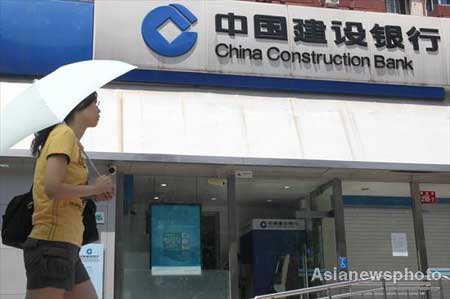Banking
China Construction Bank H1 net profit soars 27%
(Xinhua)
Updated: 2010-08-23 09:39
 |
Large Medium Small |
|
 |
|
A woman passes by an outlet of China Conconstruction Bank in Beijing on July 20,2009. |
In a filing to the Hong Kong stock exchange, CCB said its profit before tax amounted to 92.19 billion yuan, up 27.2 percent year on year.
Rapid growth in H1
Key contributors to the rapid year-on-year growth of net profit were increased credit supply, service and product innovation, and decreased impairment losses, according to the statement.
Regarding credit supply, the bank said its average balance of interest-bearing assets rose by 18.26 percent in the first half, prompting net interest income to surge by 15.33 billion yuan, or 15 percent.
On service and product innovation, CCB said net fee and commission income rose by 10.22 billion yuan, or 43.63 percent year on year, as a result of sustained rapid expansion of fee-based business.
The Beijing-based lender also said its impairment losses fell by 2.995 billion yuan, or 23.36 percent, due to price rally in foreign currency debt securities with the improving market.
CCB President Zhang Jianguo said in the statement that there were signs of recovery in developed economies and robust growth of emerging economies against the backdrop of a gradually warming-up global economy in the first half.
China has sustained rapid economic growth, thanks to the government's ongoing stimulation of domestic demand, he said.
Foreign trade has gradually improved, while investment and consumption spending have continued to expand at a fast pace, and China's overall financial market performed steadily in the first half.
Amid the European sovereign debt crisis and the Chinese government's macro-control policies in the property sector, domestic capital and property markets have undergone noticeable adjustments and are experiencing increasing uncertainties about the future market direction, he said.
According to the statement, CCB's net interest income was 117.8 billion yuan, an increase of 15.33 billion, or 14.96 percent year on year.
But compared to the same period of 2009, CCB's net interest spread for the first half of this year had dropped by two basis points to 2.32 percent, largely because the yield of interest- bearing assets decreased more than the cost of interest-bearing liabilities, it said.
In the first half, CCB's interest income surged by 11.22 billion yuan, or 6.66 percent year on year to 179.65 billion yuan. While the interest expense was 61.85 billion yuan, a year-on-year decrease of 4.12 billion yuan, or 6.24 percent.
The bank said its credit asset quality had steadily improved, with non-performing loans standing at 65.17 billion yuan by the end of June this year, a decrease of nearly 7 billion yuan over the end of 2009.
Falling NPL ratio
The NPL ratio had dropped by 0.28 percentage points from the end of 2009 to 1.22 percent at the end of June this year.
In breakdown, the NPL ratio for corporate loans dropped by 0.37 percentage points to 1.34 percent.
The NPL ratio for personal loans decreased by 0.08 percentage points to 0.58 percent.
The NPL ratio for overseas operations remained stable as a result of strengthened risk management of overseas business.
The proportion of special mention loans dropped to 3.92 percent by this June, down 0.25 percentage points over the end of 2009.
In response to the complex macro-economic situation this year, CCB said it had stepped up adjustments to its credit structure and introduced surveillance mechanisms for key risk areas in accordance with regulatory requirements to actively prevent and mitigate risks.
Post-lending management was reinforced with the launch of the " post-lending management year" campaign, and it also expedited disposal of NPLs, said the statement.
Outlook in H2
Over the outlook in the second half this year, Zhang said the complexity and uncertainty in global economy would continue to affect China's economic development, but overall the Chinese economy would keep recovery on the right track.
Consumption, investment and exports will push economic growth together with enhanced coordination, he said.
But Zhang warned that the tasks were still tough for managing inflation expectation, maintaining stable and reasonably rapid economic growth, adjusting economic structure and changing economic development pattern.
With it, Zhang said CCB would "certainly witness both opportunities and challenges".
On the one hand, the change in China's development patterns and adjustment in economic structure will facilitate adjustments in CCB's credit structure.
The progress in the liberalization of interest rate and exchange rate provides larger room for financial innovations.
Pricing capabilities will be enhanced with increased effective credit demand.
On the other hand, given the tight market liquidity and volatile capital market,deposit expansion will be more difficult.
And the pressures from regulation monitoring and peer competition set higher demand for management capabilities, he said.
Zhang said CCB would consider both current operations and long-term development, reinforce fundamental management with tighter risk management and internal controls, reasonably control loan growth, vigorously promote innovations in products and services, and proactively implement various initiatives.



